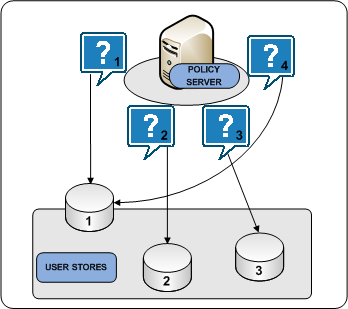Implementation Guide › Architectural Considerations › Architectural Use Cases › Redundancy and High Availability › Policy Server to User Store Communication › Round Robin Load Balancing
Round Robin Load Balancing
Round robin load balancing is an optional SiteMinder user store object setting. Round robin load balancing distributes requests evenly over a set of user stores, which:
- Results in more efficient user store queries
- Prevents a single user store from becoming overloaded with Policy Server requests
Note: Consider the following:
- For more information about configuring load balancing between LDAP user stores, see the Policy Server Configuration Guide.
- The Administrative UI does not include settings to configure round robin load balancing between ODBC user stores. However, the Policy Server installation includes:
- The SiteMinder Oracle Wire Protocol. This protocol supports load balancing over multiple Oracle stores. You can configure Oracle user store load balancing at the data source level.
- The SiteMinder SQL Server Wire Protocol, which you can use to configure SQL Server or SQL Server Cluster Enterprise. You can configure SQL Server user store load balancing at the database level.
In round robin mode, a Policy Server distributes requests across all user stores that the SiteMinder user store object lists. A Policy Server:
- Sends a request to the first user store that the user store object lists.
- Sends a request to the second user store that the user store object lists.
- Sends a request to the third user store that the user store object lists.
- Continues sending requests in this way, until the Policy Server has sent requests to all available user stores. After sending requests to all available user stores, the Policy Server returns to the first user store and the cycle begins again.
Note: Configure load balancing with failover to add the benefit of redundancy in the event of a user store failure. For more information about configuring load balancing and failover, see the Policy Server Configuration Guide.
The following diagram illustrates the user store round robin process:

